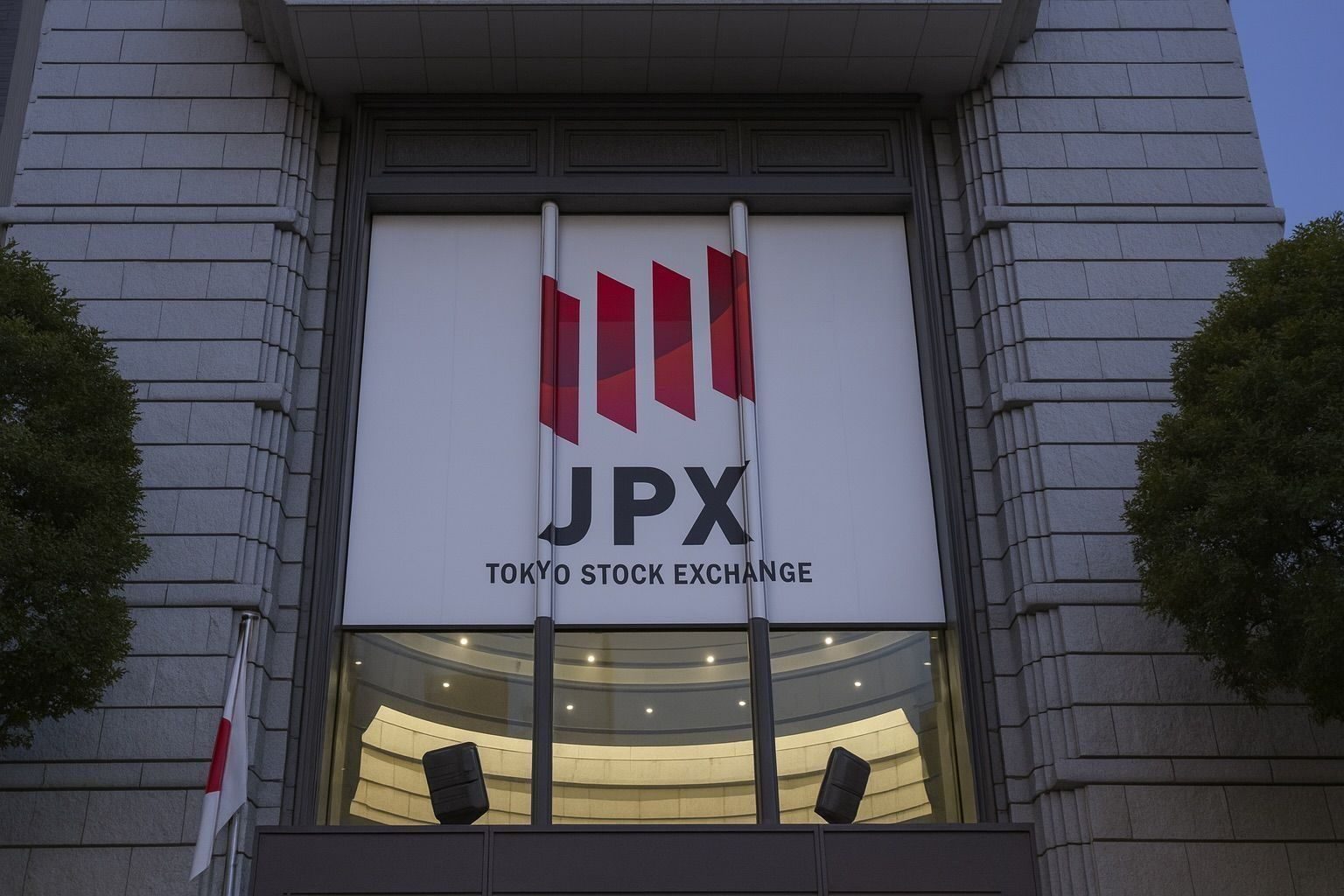Tokyo’s stock market finished Friday modestly higher, capping a strong week but a bruising month as investors weighed upbeat domestic data against persistent inflation and looming central‑bank decisions in both Japan and the United States.
The Nikkei 225 closed at 50,253.91, up 86.81 points, or 0.17%, while the broader Topix gained 0.29% to 3,378.44. [1] It was the fourth straight advance for the Nikkei, leaving the benchmark up around 3–3.5% for the week but still more than 4% lower for November, its weakest November performance since 2011. [2]
Despite profit‑taking in high‑flying tech and AI names, hopes for a U.S. Federal Reserve rate cut in December and solid Japanese economic numbers helped Tokyo break higher into the weekend. [3]
Key Tokyo market snapshot – 28 November 2025 (close)
- Nikkei 225: 50,253.91 (+0.17% on the day) [4]
- Topix: 3,378.44 (+0.29%) [5]
- Weekly performance: Nikkei up about 3.4%; Topix also higher for the week [6]
- November performance: Nikkei still down roughly 4.2%, its worst November since 2011 [7]
- Market breadth: 143 advancers vs 80 decliners on the Nikkei, indicating a broadly positive session [8]
Fed optimism offsets tech fatigue
Trading in Tokyo took place against the backdrop of holiday‑thinned global markets, with Wall Street shut on Thursday for Thanksgiving and re‑opening later Friday for a shortened session. [9]
Even so, sentiment stayed constructive:
- Futures markets now imply roughly an 85% chance that the Fed will cut rates again next month, up sharply from around 30% just a week earlier. [10]
- Global equity gauges across Asia have clawed back losses, with the region’s main ex‑Japan index up about 2–3% for the week after a volatile November dominated by worries about overheated AI and tech valuations. [11]
Xinhua reported that the Nikkei started the day under pressure as investors booked profits after a more than 1,500‑point rally over the previous three sessions, especially in heavyweight technology names. [12] But as U.S. rate‑cut hopes firmed and domestic data surprised to the upside, buyers gradually stepped back in, lifting both the Nikkei and Topix into the green by the close. [13]
Domestic data: hot Tokyo inflation, surprise housing rebound and solid output
Friday’s move on the Tokyo stock market came as investors digested a dense batch of Japanese macro data released over the last 24 hours, much of it skewing slightly stronger than expected.
Tokyo inflation stays at 2.8% – still above BoJ’s target
In Japan’s capital, core consumer prices (excluding fresh food) rose 2.8% year‑on‑year in November, unchanged from October and comfortably above the Bank of Japan’s 2% target. [14]
A narrower “core‑core” measure that strips out both fresh food and energy also rose 2.8%, underlining that underlying inflation pressures remain sticky even as some imported cost shocks fade. [15]
For equity investors, the takeaway is mixed:
- Persistent inflation supports the case for further policy normalization by the BoJ.
- But higher rates and surging government bond yields can tighten financial conditions and weigh on richly valued growth names, particularly in tech. [16]
Housing starts: first year‑on‑year rise since March
One of the biggest positive surprises came from the housing sector:
- Japan housing starts rose 3.2% year‑on‑year in October, smashing expectations for a roughly 5% decline.
- The figure also reversed a 7.3% drop in September and marked the first annual increase since March. [17]
Stronger housing activity hints at improving sentiment among households and developers despite higher construction costs and lingering uncertainty about wage growth. That, in turn, supports domestic demand–sensitive sectors such as building materials, utilities and selected retail names.
Industrial output and jobs: steady expansion with a tight labour market
On the production side, industrial output climbed 1.4% month‑on‑month in October, driven by a 6.6% jump in motor vehicle production, according to data from the Ministry of Economy, Trade and Industry. [18]
Meanwhile, Japan’s unemployment rate held at 2.6% in October for a third consecutive month, signalling a still‑tight labour market even as the absolute number of jobless people ticked higher. [19]
Taken together:
- Output is expanding at a moderate pace.
- Labour conditions remain historically tight.
- Inflation is above target but not accelerating.
That combination keeps pressure on the BoJ to continue normalising policy while giving equity markets some comfort that the economy is not stalling out.
Sector moves: AI and chip names cool, machinery stocks shine
Beneath the index‑level gains, today’s session in Tokyo reflected an ongoing rotation away from frothy AI plays and toward more cyclical and value‑oriented names.
Tech and AI: taking a breather
Earlier in the Asian day, versions of the Associated Press market story noted that AI‑linked stocks including Kioxia Holdings, Fujikura and Lasertec were among the notable decliners, leaving the Nikkei around 50,172.60 and essentially flat at that point in the session. [20]
That weakness follows a rollercoaster month in which concerns about an “AI bubble” triggered sharp sell‑offs in high‑multiple chip and software names across Asia before Fed‑driven optimism helped stabilise markets. [21]
Although these intraday tech losses were largely absorbed by the close, they illustrate a more selective risk appetite:
- Investors are less willing to chase AI winners at any price.
- Short‑term flows are rotating into stocks perceived as beneficiaries of domestic capex, infrastructure and re‑shoring trends, rather than pure AI narratives.
Industrials and cyclicals: Okuma and Furukawa Electric lead
Data from Reuters, carried by The Economic Times, showed that market breadth was broadly positive, with 143 stocks rising and 80 falling on the Nikkei. [22]
Notable movers included:
- Okuma – the machine‑tool manufacturer was the top Nikkei gainer, jumping about 6.7%, as investors bet that improving global manufacturing and robust Japanese capital spending will support demand for factory automation equipment. [23]
- Furukawa Electric – shares climbed roughly 4.7%, buoyed by expectations for continued investment in power grids, EV components and communication infrastructure. [24]
- On the downside, Mitsui Mining & Smelting (Mitsui Kinzoku) and Toho were among the largest decliners, each sliding around 2%, suggesting some profit‑taking in materials and select defensives after a choppy month. [25]
This tilt towards machinery and infrastructure‑linked names fits neatly with today’s data showing stronger housing activity and solid auto production – both supportive of demand for industrial equipment and components. [26]
Currency and bonds: weak yen, higher yields and equity implications
Beyond equities, Tokyo traders remain laser‑focused on the yen and Japanese government bonds (JGBs):
- The dollar traded around ¥156.3 on Friday, leaving the yen near a 10‑month low and fuelling speculation that authorities could step in if the currency weakens much further. [27]
- At the same time, 10‑year JGB yields have climbed to their highest level in about 17 years, while 30‑year yields have hit record highs, reflecting market unease about the massive fiscal stimulus program promised by Prime Minister Sanae Takaichi. [28]
For stocks, this mix is nuanced:
- A weaker yen tends to support exporters, including automakers and some industrial firms.
- Higher yields can help banks, insurers and other financials, but they also raise the discount rate for future earnings, which hurts long‑duration growth stocks—again, particularly in tech. [29]
Today’s moderate rise in the Nikkei and Topix suggests that, for now, equity investors are comfortable with this trade‑off, especially with the Fed seemingly closer to easing than tightening further. [30]
BoJ in focus: December 18–19 meeting looms large
With inflation in Tokyo holding above target and real‑world data like housing and factory output improving, attention is swinging firmly toward the Bank of Japan’s final policy meeting of 2025, scheduled for December 18–19. [31]
Key points investors are watching:
- A Reuters poll this week found that a slim majority of economists now expect the BoJ to raise its policy rate at that December meeting, after having already begun its exit from ultra‑loose policy earlier this year. [32]
- BoJ board member Asahi Noguchi has recently argued for gradual but continued rate hikes, warning that keeping real interest rates too low for too long could stoke unwanted inflation and distort the economy. [33]
- At the same time, policymakers must weigh still‑fragile consumption and a third‑quarter GDP contraction, even as October’s data painted a somewhat brighter picture. [34]
For Tokyo equities, the base‑case scenario priced in today seems to be:
- A cautious BoJ rate hike path – enough to anchor inflation expectations and stabilise the yen,
- But not so aggressive that it chokes off domestic demand or triggers a sharp repricing of risk assets.
That balance helps explain why financials and cyclicals found buyers today even as high‑growth tech remained under pressure.
Outlook: what Tokyo traders will watch next
Looking beyond today’s close, several themes will likely dominate Tokyo stock market conversations in the coming days:
- Fed signalling and U.S. data
- Any shift in tone from Fed officials or surprises in U.S. jobs and inflation data could reinforce or undermine December rate‑cut expectations, with knock‑on effects for global risk appetite and the yen. [35]
- BoJ communication ahead of the December 18–19 meeting
- Speeches by Governor Kazuo Ueda and other board members, plus any leaks or press reports, will be scrutinised for clues on whether the BoJ is ready to move again this month or wait until 2026. [36]
- JGB auctions and market reaction
- Upcoming 10‑year and 30‑year JGB auctions will test investor demand at higher yields; a weak take‑up could push yields even higher and add pressure on equities, especially in rate‑sensitive sectors. [37]
- Rotation within Japanese equities
- After an AI‑driven surge earlier in the year and a sharp correction this month, investors appear to be re‑balancing toward industrials, financials and domestically exposed names. How long that rotation lasts will depend on both global tech sentiment and the trajectory of Japanese rates. [38]
For now, the story of Friday, November 28, 2025 is that Tokyo’s stock market managed a controlled, data‑backed climb, ending the week on firmer footing even as the bigger battles over inflation, interest rates and AI valuations remain very much unresolved.
References
1. english.news.cn, 2. m.economictimes.com, 3. www.reuters.com, 4. english.news.cn, 5. english.news.cn, 6. m.economictimes.com, 7. m.economictimes.com, 8. m.economictimes.com, 9. apnews.com, 10. energynews.oedigital.com, 11. www.reuters.com, 12. english.news.cn, 13. english.news.cn, 14. apnews.com, 15. www.icis.com, 16. www.reuters.com, 17. www.investing.com, 18. english.news.cn, 19. www.china.org.cn, 20. www.kare11.com, 21. www.thejakartapost.com, 22. m.economictimes.com, 23. m.economictimes.com, 24. m.economictimes.com, 25. m.economictimes.com, 26. www.investing.com, 27. apnews.com, 28. www.reuters.com, 29. www.reuters.com, 30. www.reuters.com, 31. www.mnimarkets.com, 32. www.reuters.com, 33. www.reuters.com, 34. www.reuters.com, 35. energynews.oedigital.com, 36. www.reuters.com, 37. www.reuters.com, 38. www.thejakartapost.com










